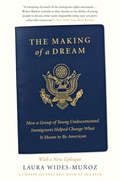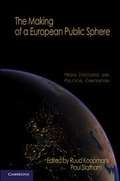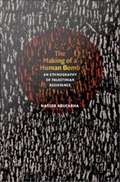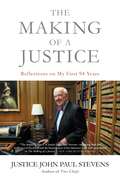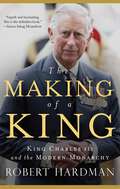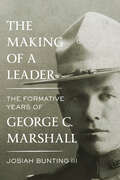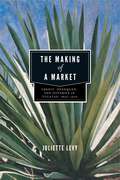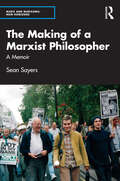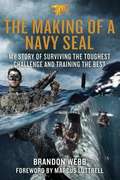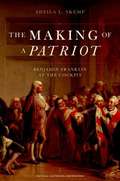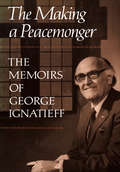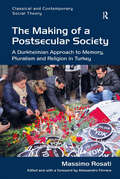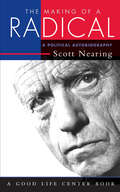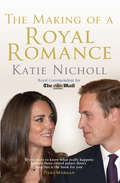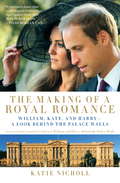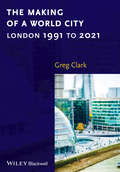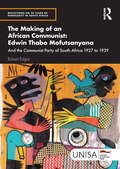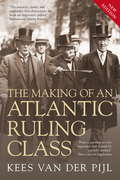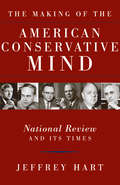- Table View
- List View
The Making of a Dream: How a Group of Young Undocumented Immigrants Helped Change What It Means to Be American
by Laura Wides-MuñozA journalist chronicles the next chapter in civil rights—the story of a movement and a nation, witnessed through the poignant and inspiring experiences of five young undocumented activists who are transforming society’s attitudes toward one of the most contentious political matters roiling America today: immigration.They are called the DREAMers: young people who were brought, or sent, to the United States as children and who have lived for years in America without legal status. Growing up, they often worked hard in school, planned for college, only to learn they were, in the eyes of the United States government and many citizens, "illegal aliens."Determined to take fate into their own hands, a group of these young undocumented immigrants risked their safety to "come out" about their status—sparking a transformative movement, engineering a seismic shift in public opinion on immigration, and inspiring other social movements across the country. Their quest for permanent legal protection under the so-called "Dream Act," stalled. But in 2012, the Obama administration issued a landmark, new immigration policy: Deferred Action for Childhood Arrivals, or DACA, which has since protected more than half a million young immigrants from deportation even as efforts to install more expansive protections remain elusive.The Making of a Dream begins at the turn of the millennium, with the first of a series of "Dream Act" proposals; follows the efforts of policy makers, activists, and undocumented immigrants themselves, and concludes with the 2016 presidential election and the first months of the Trump presidency. The immigrants’ coming of age stories intersect with the watershed political and economic events of the last two decades: 9/11, the recession, the wars in Iraq and Afghanistan, the Obama presidency, and the rebirth of the anti-immigrant right.In telling their story, Laura Wides-Muñoz forces us to rethink our definition of what it means to be American.
The Making of a European President
by Nereo Pe�alver Garc�a Julian PriestleyThis book tells the inside story of how a putsch" was organised in a Europe in crisis, how a small group of European politicians from different parties brought about the biggest change in twenty years in the way the EU decides its leadership. The authors describe first-hand Europe's first presidential campaign, the personalities, how the candidates were chosen, the controversies and incidents on the campaign trail, the policy differences, the rallies in the battleground states, the useof social media, and the TV debates. It gives a blow-by-blow account of how Europe's most powerful leading governments were forced to make a humiliating climb-down and accept the election of a leader they did not support, chosen by a process they opposed. But the book also analyses critically this new way of electing the President, what needs to change for 2019, and sets what happened in a broader historical context. A unique trip to the "kitchen" of EU politics. "
The Making of a European Public Sphere
by Ruud Koopmans Paul StathamThis book investigates an important source of the European Union's recent legitimacy problems. It shows how European integration is debated in mass media, and how this affects democratic inclusiveness. Advancing integration implies a shift in power between governments, parliaments, and civil society. Behind debates over Europe's "democratic deficit" is a deeper concern: whether democratic politics can perform effectively under conditions of Europeanization and globalization. This study is based on a wealth of unique data from seven European countries, combining newspaper content analyses, an innovative study of Internet communication structures, and hundreds of interviews with leading political and media representatives across Europe. It is by far the most far-reaching and empirically grounded study on the Europeanization of media discourse and political contention to date, and a must-read for anyone interested in how European integration changes democratic politics and why European integration has become increasingly contested.
The Making of a Human Bomb: An Ethnography of Palestinian Resistance
by Nasser AbufarhaIn The Making of a Human Bomb, Nasser Abufarha, a Palestinian anthropologist, explains the cultural logic underlying Palestinian martyrdom operations (suicide attacks) launched against Israel during the Al-Aqsa Intifada (2000-06). In so doing, he sheds much-needed light on how Palestinians have experienced and perceived the broader conflict. During the Intifada, many of the martyrdom operations against Israeli targets were initiated in the West Bank town of Jenin and surrounding villages. Abufarha was born and raised in Jenin. His personal connections to the area enabled him to conduct ethnographic research there during the Intifada, while he was a student at a U. S. university. Abufarha draws on the life histories of martyrs, interviews he conducted with their families and members of the groups that sponsored their operations, and examinations of Palestinian literature, art, performance, news stories, and political commentaries. He also assesses data--about the bombers, targets, and fatalities caused--from more than two hundred martyrdom operations carried out by Palestinian groups between 2001 and 2004. Some involved the use of explosive belts or the detonation of cars; others entailed armed attacks against Israeli targets (military and civilian) undertaken with the intent of fighting until death. In addition, he scrutinized suicide attacks executed by Hamas and Islamic Jihad between 1994 and 2000. In his analysis of Palestinian political violence, Abufarha takes into account Palestinians' understanding of the history of the conflict with Israel, the effects of containment on Palestinians' everyday lives, the disillusionment created by the Oslo peace process, and reactions to specific forms of Israeli state violence. The Making of a Human Bomb illuminates the Palestinians' perspective on the conflict with Israel and provides a model for ethnographers seeking to make sense of political violence.
The Making of a Justice: Reflections on My First 94 Years
by John Paul StevensA "timely and hugely important" account of his life on the Supreme Court (New York Times)When Justice John Paul Stevens retired from the Supreme Court of the United States in 2010, he left a legacy of service unequaled in the history of the Court. During his thirty-four-year tenure, Justice Stevens was a prolific writer, authoring more than 1000 opinions. In THE MAKING OF A JUSTICE, John Paul Stevens recounts his extraordinary life, offering an intimate and illuminating account of his service on the nation's highest court. Appointed by President Gerald Ford and eventually retiring during President Obama's first term, Justice Stevens has been witness to, and an integral part of, landmark changes in American society. With stories of growing up in Chicago, his work as a naval traffic analyst at Pearl Harbor during World War II, and his early days in private practice, as well as a behind-the-scenes look at some of the most important Supreme Court decisions over the last four decades, THE MAKING OF A JUSTICE offers a warm and fascinating account of Justice Stevens' unique and transformative American life.This comprehensive memoir is a must read for those trying to better understand our country.
The Making of a King: King Charles III and the Modern Monarchy
by Robert HardmanThe dramatic story of the new king&’s evolution over the past year from Prince of Wales to King Charles III, from one of the most acclaimed royal biographers writing today.No British monarch has had a tougher act to follow. Now, after seventy years of waiting and preparation, King Charles III is not just the head of the most famous family in the world. He is the custodian of a thousand-year-old institution which must redefine its place in the digital age while others insist on rewriting the past. With unrivaled access to the king, the royal family, and the court, leading royal authority Robert Hardman brings us the inside story on the most pivotal and challenging year for the monarchy in living memory. From the death of Elizabeth II through to the ancient spectacle of the Coronation, from the rise of a new Prince and Princess of Wales to the latest "truth bombs" from the Sussexes, this is the story of the making of a monarch.
The Making of a Leader: The Formative Years of George C. Marshall
by Josiah BuntingA portrait of one of the greatest leaders of modern history, George Catlett Marshall (1880–1959), and a distillation of the essential lessons his formative years offer to the leaders of today and tomorrowGeorge Marshall&’s accomplishments are well known: after helping to guide the Allies to victory during World War II, he set Europe on the postwar path to recovery with the plan that bears his name and was awarded the Nobel Peace Prize in 1953. But how did he become such an effective leader?By eschewing the years and accomplishments for which Marshall is most often remembered and focusing instead on the decisive moments that preceded them, The Making of a Leader provides the most detailed look yet at the mettle of Marshall&’s character, from his arrival as a cadet at the Virginia Military Institute and his Fort Leavenworth days—where he &“learned how to learn&”—to his instructive time as John J. Pershing&’s aide-de-camp and his critical experiences during World War I. Josiah Bunting III, a lifelong educator and former superintendent of Marshall&’s alma mater, highlights the importance of Marshall&’s activity between the wars, when he led &“the single most influential period of military education&” at Fort Benning, eventually culminating in his appointment as Army Chief of Staff in 1939.In this illuminating portrait, Bunting cuts through the legend of Marshall to the man—his frustrations, passions, loves, and brilliance—revealing a humble commander who knew not only how to lead but how to see the leader in others.
The Making of a Market: Credit, Henequen, and Notaries in Yucatán, 1850–1900
by Juliette LevyDuring the nineteenth century, Yucatán moved effectively from its colonial past into modernity, transforming from a cattle-ranching and subsistence-farming economy to a booming export-oriented agricultural economy. Yucatán and its economy grew in response to increasing demand from the United States for henequen, the local cordage fiber. This henequen boom has often been seen as another regional and historical example of overdependence on foreign markets and extortionary local elites. In The Making of a Market, Juliette Levy argues instead that local social and economic dynamics are the root of the region’s development. She shows how credit markets contributed to the boom before banks (and bank crises) existed and how people borrowed before the creation of institutions designed specifically to lend. As the intermediaries in this lending process, notaries became unwitting catalysts of Yucatán’s capitalist transformation. By focusing attention on the notaries’ role in structuring the mortgage market rather than on formal institutions such as banks, this study challenges the easy compartmentalization of local and global relationships and of economic and social relationships.
The Making of a Marxist Philosopher: A Memoir (Marx and Marxisms)
by Sean SayersThe Making of a Marxist Philosopher is a revealing and beautifully written memoir and family history from renowned Marxist philosopher Sean Sayers.His father was the son of a Jewish-Irish businessman who was a friend of Michael Collins and other leaders in the Irish struggle for independence. He became a writer who was given his first job by T. S. Eliot, shared a flat with George Orwell, went to America and was blacklisted under McCarthyism. Sean’s mother was the American-born daughter of a world famous Italian American anarchist. She became a communist and lived and worked in China. Sean was born in New York and grew up in London. He studied philosophy in Cambridge and Oxford Universities in the 1960s and has become an internationally known Marxist philosopher. As one of the founders of the journal Radical Philosophy and the creator of the Marx and Philosophy Review of Books, Sayers has been at the centre of the development of philosophy on the left in the English-speaking world during the past fifty years.Reflecting on the fate of Marxism in an engaging, thoughtful way, The Making of a Marxist Philosopher is filled with revealing family photographs which Sayers uses to craft an original must-read on left-wing thought and politics.
The Making of a Navy Seal: My Story of Surviving the Toughest Challenge and Training the Best
by John David Mann Brandon WebbBorn Ready for Action Boot Camp Training Becoming a Navy SEAL One of America's Deadliest Snipers Duty Calls Continuing to Protect and Defend
The Making of a New Rural Order in South China
by Joseph P. McdermottAmong the large caches of private documents discovered and collected in China, few rival the Huizhou sources for the insight they provide into Chinese local society and economy over the past millennium. Having spent decades researching these exceptionally rich sources, Joseph P. McDermott presents in two volumes his findings about the major social and economic changes in this important prefecture of south China from around 900 to 1700. In this first volume, we learn about village settlement, competition among village religious institutions, premodern agricultural production, the management of land and lineage, the rise of the lineage as the dominant institution, and its members' application of commercial practices to local forestry operations. This landmark study of religious life and economic activity, of lineage and land, and of rural residents and urban commercial practices provides a compelling new framework for understanding a distinctive path of economic and social development for premodern China and beyond.
The Making of a Patriot: Benjamin Franklin at the Cockpit
by Sheila L. SkempOn January 29, 1774, Benjamin Franklin was called to appear before the Privy Council - a select group of the King's advisors - in an octagonal-shaped room in Whitehall Palace known as the Cockpit. Spurred by jeers and applause from the audience in the Cockpit, Solicitor General AlexanderWedderburn unleashed a withering tirade against Franklin. Though Franklin entered the room as a dutiful servant of the British crown, he left as a budding American Revolutionary. In The Making of a Patriot, renowned Franklin historian Sheila Skemp presents a insightful, lively narrative that goes beyond the traditional Franklin biography - and behind the common myths - to demonstrate how Franklin's ultimate decision to support the colonists was by no means a foregoneconclusion. In fact, up until the Cockpit ordeal, he was steadfastly committed to achieving "an accommodation of our differences. " The Making of a Patriot also sheds light on the conspiratorial framework within which actors on both sides of the Atlantic moved toward revolution and it highlights howthis event ultimately pitted Franklin against his son, suggesting that the Revolution was, in no small part, also a civil war.
The Making of a Peacemonger: The Memoirs of George Ignatieff
by George IgnatieffStanding on the roof of Canada House following one of the worst wartime air raids on London and surveying the devastation around them, two men resolved to devote their lives to the cause of peace. One of them was Mike Pearson, soon to become minister of external affairs and eventually prime minister of Canada. The other was a junior foreign service official by the name of George Ignatieff. The London blitz was not Ignatieff's first exposure to the horrors of war. As the Russian-born son of a famous aristocratic family, he was barely five years old when the revolution and civil war put an end to his sheltered childhood. His father was arrested and jailed by the Bolsheviks, then miraculously released in time for the family to escape to England and eventually settle in Canada. For the last event, he has never ceased to be grateful. With warmth, charm and unfailing humour, Ignatieff takes the reader through a remarkable life. The early years – from the elegance of his childhood home to the comic struggles of émigré neophytes operating a dairy farm, from the pain of isolation at an exclusive Montreal boys' school and the challenges of railroad construction life in western Canada to the heady days as a Rhodes scholar at Oxford – developed in the young man the flexibility and adaptability required of a diplomat. His close-up observation of troops massed to parade before Hitler, his shock at the atomic bombing of Hiroshima and Magasaki, the nuclear arms race, and the Cuban missile crisis all reinforced his commitment to peace. Ignatieff served his adopted country as Canadian ambassador to Yugoslavia and to the North Atlantic Council. He represented Canada on the United Nations Security Council and at the Geneva Disarmament Conference. He participated in tense negotiations over most of the world's hot spots of the 1950s and 60s: the Middle east, Suez, Korea, Czechoslovakia, Cyprus. He accompanied Pearson on his historic visit to the Soviet Union, and spent a memorable evening with Khrushchev and Bulganin. He discussed multiculturalism with Tito, the Suez crisis with U Thant, and disarmament with anyone who would listen. His colourful recollections offer a rare glimpse into the workings of international relations, of policy-making at the highest levels, and of people whose decisions affect the stability of the world. They are also the intensely personal account of an immigrant who rose to distinguished heights in service to his country and to humanity.
The Making of a Periphery: How Island Southeast Asia Became a Mass Exporter of Labor (Columbia Studies in International and Global History)
by Ulbe BosmaIsland Southeast Asia was once a thriving region, and its products found eager consumers from China to Europe. Today, the Philippines, Indonesia, and Malaysia are primarily exporters of their surplus of cheap labor, with more than ten million emigrants from the region working all over the world. How did a prosperous region become a peripheral one?In The Making of a Periphery, Ulbe Bosma draws on new archival sources from the colonial period to the present to demonstrate how high demographic growth and a long history of bonded labor relegated Southeast Asia to the margins of the global economy. Bosma finds that the region’s contact with colonial trading powers during the early nineteenth century led to improved health care and longer life spans as the Spanish and Dutch colonial governments began to vaccinate their subjects against smallpox. The resulting abundance of workers ushered in extensive migration toward emerging labor-intensive plantation and mining belts. European powers exploited existing patron-client labor systems with the intermediation of indigenous elites and non-European agents to develop extractive industries and plantation agriculture. Bosma shows that these trends shaped the postcolonial era as these migration networks expanded far beyond the region. A wide-ranging comparative study of colonial commodity production and labor regimes, The Making of a Periphery is of major significance to international economic history, colonial and postcolonial history, and Southeast Asian history.
The Making of a Postsecular Society: A Durkheimian Approach to Memory, Pluralism and Religion in Turkey (Classical and Contemporary Social Theory)
by Massimo RosatiDrawing on the thought of Durkheim, this volume focuses on societal changes at the symbolic level to develop a new conceptualisation of the emergence of postsecular societies. Neo-Durkheimian categories are applied to the case of Turkey, which in recent years has shifted from a strong Republican and Kemalist view of secularism to a more Anglo-Saxon perspective. Turkish society thus constitutes an interesting case that blurs modernist distinctions between the secular and the religious and which could be described as ’postsecular’. Presenting three symbolic case studies - the enduring image of the founder of the Republic Atatürk, the contested site of Ayasofia, and the remembering and commemoration of the murdered journalist Hrant Dink - The Making of a Postsecular Society analyses the cultural relationship that the modern Republic has always had with Europe, considering the possible implications of the Turkish model of secularism for a specifically European self-understanding of modernity. Based on a rigorous construction of theoretical categories and on a close scrutiny of the common challenges confronting Europe and its Turkish neighbour long considered ’other’ with regard to the accommodation of religious difference, this book sheds light on the possibilities for Europe to find new ways of arranging the relationship between the secular and the religious. As such, it will appeal to scholars of social theory, the sociology of religion, secularisation and religious difference, and social change.
The Making of a Protest Movement in Turkey: #occupygezi
by Umut ÖzkırımlıThe aim of this collection of essays, the first academic book on the topic in English, is to offer a preliminary analysis of Gezi protests and address the following questions: 'How can we account for the protests?' and 'Who were the protesters?'
The Making of a Radical
by Scott NearingScott Nearing lived one hundred years, from 1883 to 1983--a life spanning most of the twentieth century. In his early years, Nearing made his name as a formidable opponent of child labour and military imperialism. Having been fired from university jobs for his independence of mind, Nearing became a freelance lecturer and writer, traveling widely through Depression-era and post-war America to speak with eager audiences. Five-time Socialist candidate for president Eugene V. Debs said, "Scott Nearing! He is the greatest teacher in the United States. " Concluding that it would be better to be poor in the country than in New York City, Scott and Helen Nearing moved north to Vermont in 1932 and commenced the experiment in self-reliant living that would extend their fame far and wide. They began to grow most of their own food, and devised their famous scheme for allocating the day's hours: one third for "bread work" (livelihood), one third for "head work" (intellectual endeavors), and one third for "service to the world community. " Scott (who'd grown up partly on his grandfather's Pennsylvania farm) taught Helen (who was raised in suburbia, groomed for a career as a classical violinist) the practical skills they would need: working with tools, cultivating a garden and managing a woodlot, and building stone and masonry walls. For the rest of their lives, the Nearings chronicled in detail their "good life," first in Vermont and ultimately on the coast of Maine, in a group of wonderful books--many of which are now being returned to print by Chelsea Green in cooperation with the Good Life Center, an educational trust established at the Nearings' Forest Farm in Harborside, Maine, to promote their ongoing legacy. With a new foreword by activist historian Staughton Lynd, The Making of a Radical is freshly republished-Scott Nearing's own story, told as only he could tell it.
The Making of a Royal Romance
by Katie NichollKatie Nicholl, Royal Correspondent for the Mail on Sunday, has been at the centre of royal reporting since she joined the newspaper in 2001. There is no one who is more intimately acquainted with the lives and loves of Princes William and Harry. Katie has spoken to a wealth of contacts close to William and Catherine Middleton and reveals how their love affair really started at St Andrews, the hurdles the pair overcame and the challenges they still face.Originally published to great acclaim in 2010 as William and Harry, Katie Nicholl has updated and added to her original account of the princes' lives and recounts the definitive story of William's royal romance with the young woman destined to become Queen Catherine.
The Making of a Royal Romance: Behind the Palace Walls)
by Katie Nicholl"William and Harry" was an overnight sensation when it was published a week before Prince William and Kate MiddletonOCOs engagement announcement in November 2010. Now the author, a royal insider and the royal correspondent for "The Daily Mail, " has updated and added crucial material that completes the story of the fairytale romance. In addition to providing fascinating insight into the lives and loves of two young men who are very much in the public spotlight worldwide, this updated version now becomes the definitive book that brings their storyOCoand that of Kate Middleton, the future Queen CatherineOCoup to date. aWith a new preface, an epilogue, and two new chapters, the author now fully reveals the secret marriage pact that William and Kate have had for several years, dispelling the notion that Kate Middleton has been OC Waity Katie. OCO It paints a portrait of Kate by looking back at her family and childhood, her close friends and former boyfriends, and her ever-present devotion to the love of her life, Prince William. It reveals the domestic life that the two have been living in Wales, and provides a look at what the future holds for their new commitment. The epilogue focuses on the wedding preparations. aThe book will be the most authoritative and entertaining guide to the royal familyOCOs most widely anticipated public event since the wedding of Lady Diana Spencer and Prince Charles. "
The Making of a Southern Democracy
by Tom EamonThe story of modern politics in North Carolina is very much one of American democracy, with all its grand ambitions, limitations, and pitfalls. So argues Tom Eamon in his probing narrative of the state's political path since the 1940s. He charts the state's political transformation into a modern democratic society to show that this change was more than an evolution--it was a revolution, one that largely came about through political means, driven by strong movements and individuals working for change. By tracking the turbulence of politics throughout the period, from racial tensions to student demonstrations to fierce rivalries in the higher education arena, Eamon explores how conflict helped build a better society even as the state continued to lag in many areas. This rich account opens to readers the unforgettable people and hard-fought elections that have shaped North Carolina's competitive personality and have led to the state's emergence as a major player in twenty-first-century American politics.
The Making of a World City: London 1991 to 2021
by Greg ClarkAfter two decades of evolution and transformation, London had become one of the most open and cosmopolitan cities in the world. The success of the 2012 Olympics set a high water-mark in the visible success of the city, while its influence and soft power increased in the global systems of trade, capital, culture, knowledge, and communications. The Making of a World City: London 1991 - 2021 sets out in clear detail both the catalysts that have enabled London to succeed and also the qualities and underlying values that are at play: London’s openness and self-confidence, its inventiveness, influence, and its entrepreneurial zeal. London’s organic, unplanned, incremental character, without a ruling design code or guiding master plan, proves to be more flexible than any planned city can be. Cities are high on national and regional agendas as we all try to understand the impact of global urbanisation and the re-urbanisation of the developed world. If we can explain London’s successes and her remaining challenges, we can unlock a better understanding of how cities succeed.
The Making of an African Communist: And the Communist Party of South Africa 1927 to 1939 (30 Years of Democracy in South Africa)
by Robert EdgarThis book is a short biography of the life of Edwin Thabo Mofutsanyana – the General Secretary of the Communist Party of South Africa. Set against the backdrop of political crisis in South Africa, the subject matter in this book discusses Mofutsanyana’s political endeavors and his service and contribution to the freedom struggle.Print editions not for sale in Sub-Saharan Africa. This book is part of Routledge’s co-published series 30 Years of Democracy in South Africa, in collaboration with UNISA Press, which reflects on the past years of a democratic South Africa and assesses the future opportunities and challenges.
The Making of an Atlantic Ruling Class
by Kees Van Der PijlWith The Making of an Atlantic Ruling Class, Kees van der Pijl put class formation at the heart of our understanding of world politics and the global economy. This landmark study dissects one of the most decisive phenomena of the twentieth century--the rise of an Atlantic ruling class of multinational banks and corporations. A new preface by the author evaluates the book's significance in the light of recent political and economic developments.
The Making of an SS Killer
by Kay Alex J.In this pioneering biography of a frontline Holocaust perpetrator, Alex J. Kay uncovers the life of SS Lieutenant Colonel Alfred Filbert, responsible as the first head of SS-Einsatzkommando 9, a mobile killing squad, for the murder of more than 18,000 Soviet Jews - men, women and children - on the Eastern Front. He reveals how Filbert, following the political imprisonment of his older brother, set out to prove his own ideological allegiance by displaying particular radicalism in implementing the orders issued by Hitler, Himmler and Heydrich. He also examines Filbert's post-war experiences, first in hiding and then being captured, tried and sentenced to life imprisonment. Released early, Filbert went on to feature in a controversial film in the lead role of an SS mass murderer. The book provides compelling new insights into the mindset and motivations of the men, like Filbert, who rose through the ranks of the Nazi regime.
The Making of the American Conservative Mind: National Review and Its Times
by Jeffrey HartNational Review has been the leading conservative national magazine since it was founded in 1955, and in that capacity it has played a decisive role in shaping the conservative movement in the United States. In The Making of the American Conservative Mind, Jeffrey Hart provides an authoritative and high-spirited history of how the magazine has come to define and defend conservatism for the past fifty years. He also gives a firsthand account of the thought and sometimes colorful personalities—including James Burnham, Willmoore Kendall, Russell Kirk, Frank Meyer, William Rusher, Priscilla Buckley, Gerhart Niemeyer, and, of course, the magazine&’s founder, William F. Buckley Jr.—who contributed to National Review&’s life and wide influence.As Hart sees it, National Review has regularly veered toward ideology, but it has also regularly corrected its course toward, in Buckley&’s phrase, a &“politics of reality.&” Its catholicity and originality—attributable to Buckley&’s magnanimity and sense of showmanship—has made the magazine the most interesting of its kind in the nation, concludes Hart. His highly readable and occasionally contrarian history, the first history of National Review yet published, marks another milestone in our understanding of how the conservatism now so influential in American political life draws from, and in some ways repudiates, the intellectual project that National Review helped launch a half century ago.
